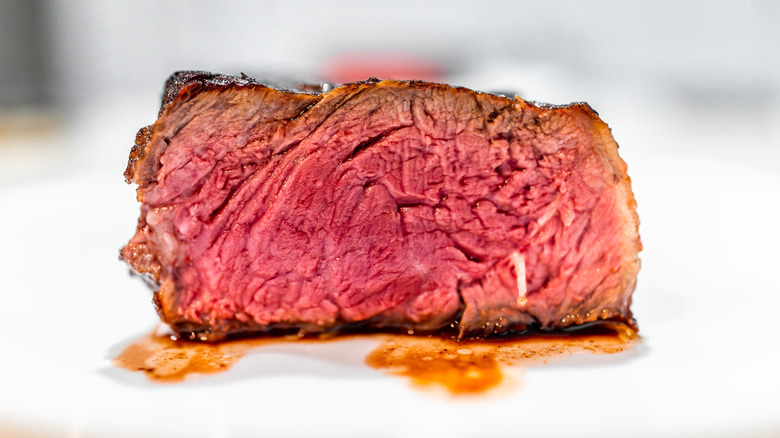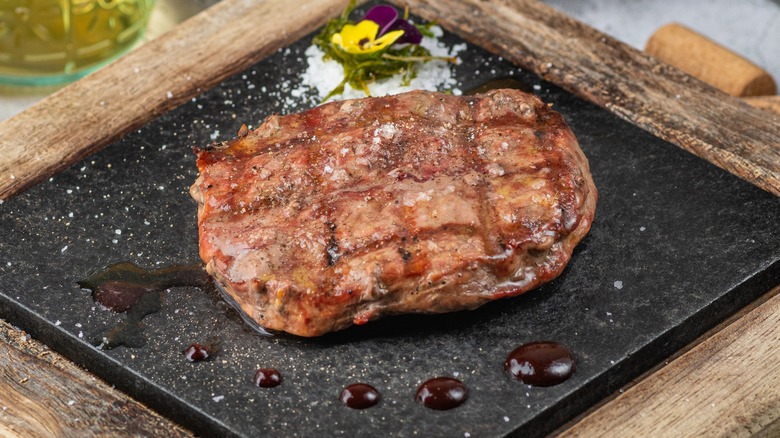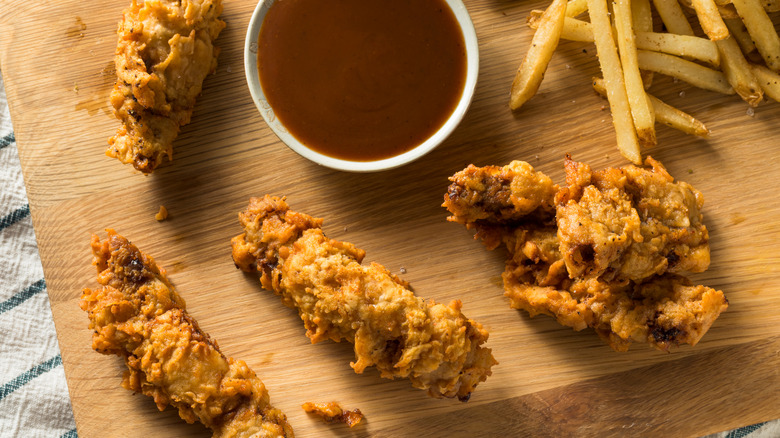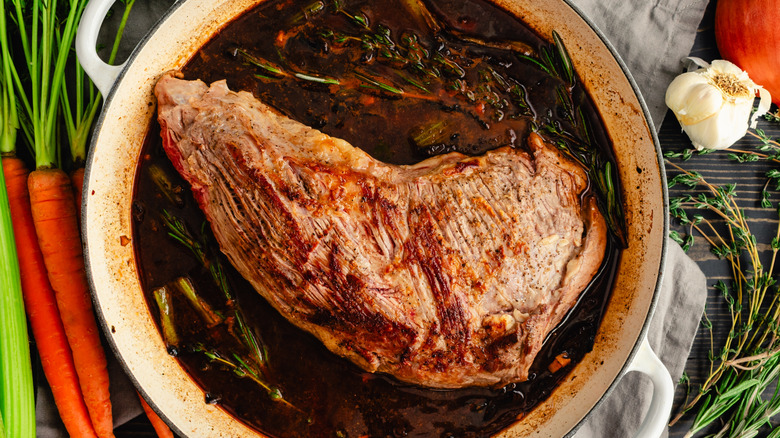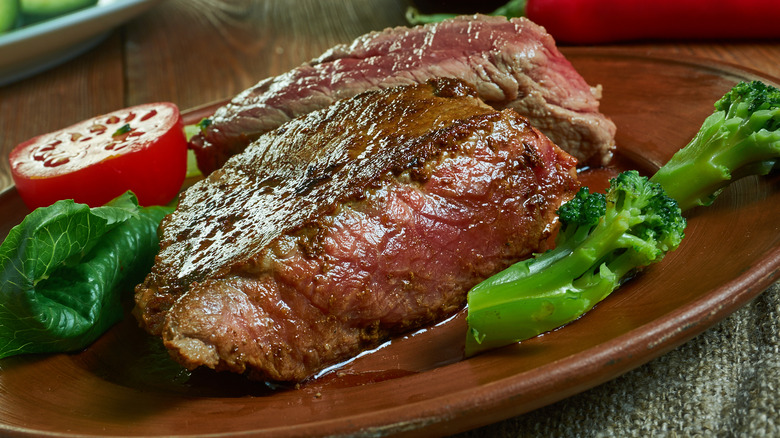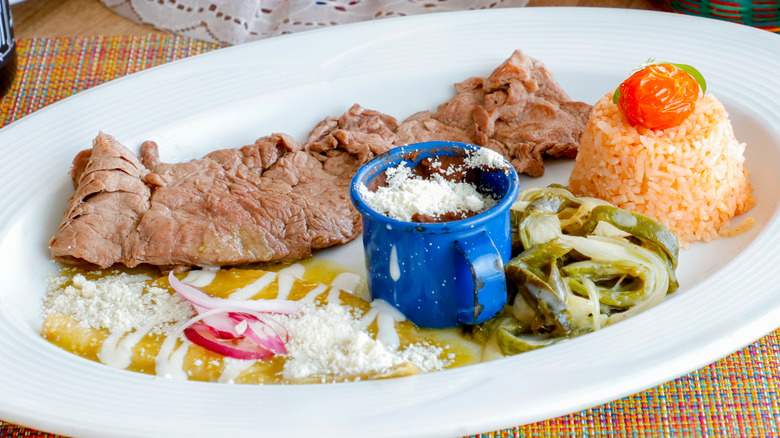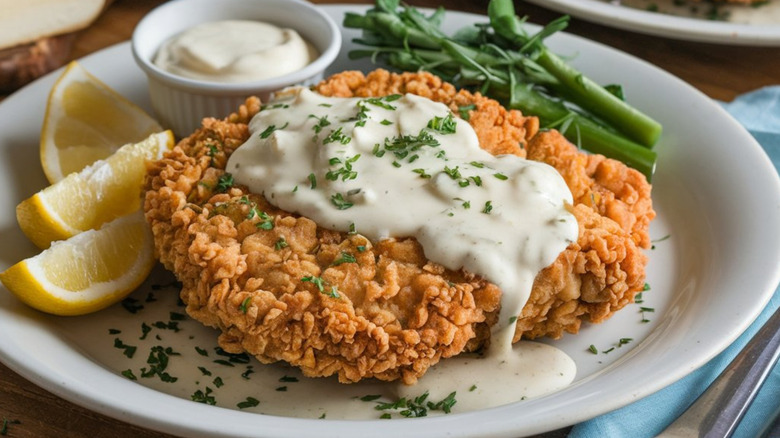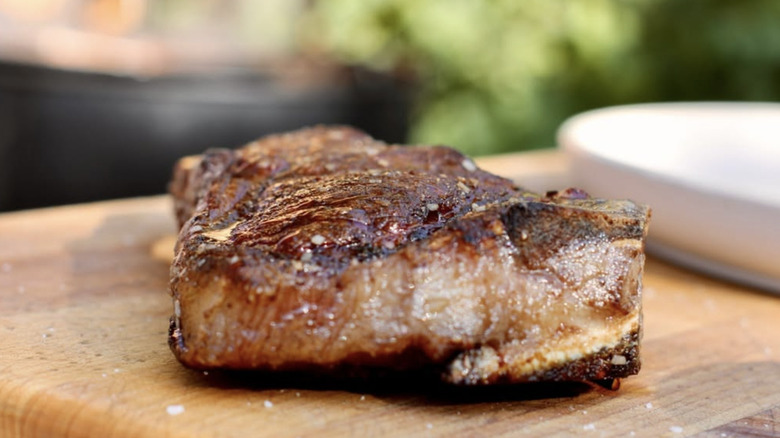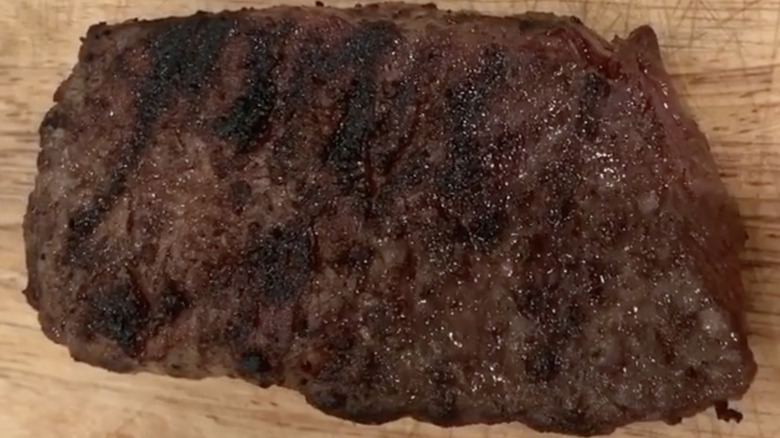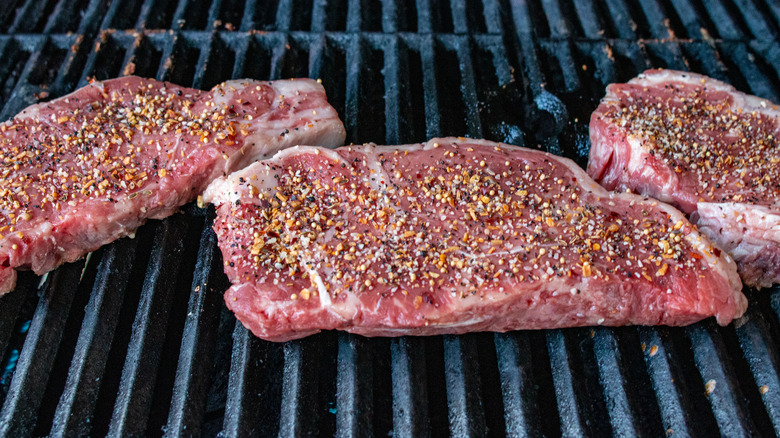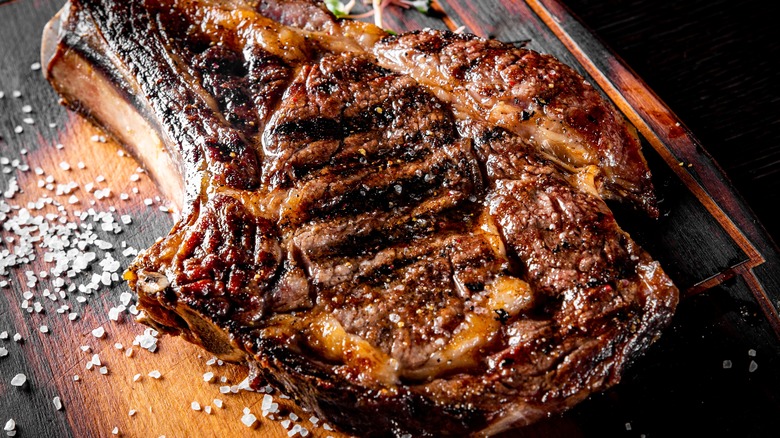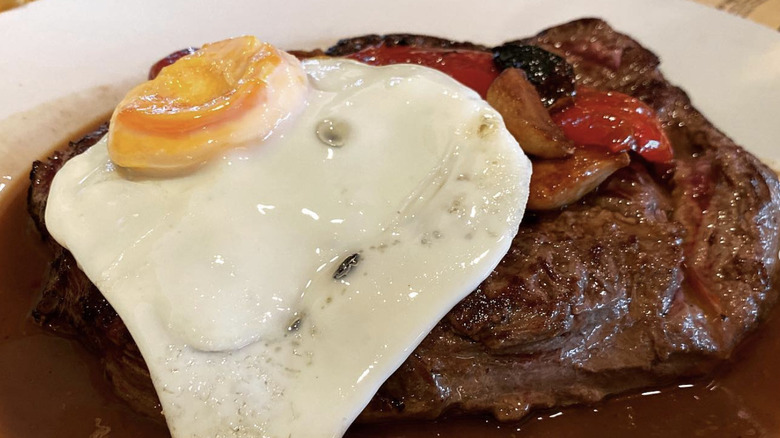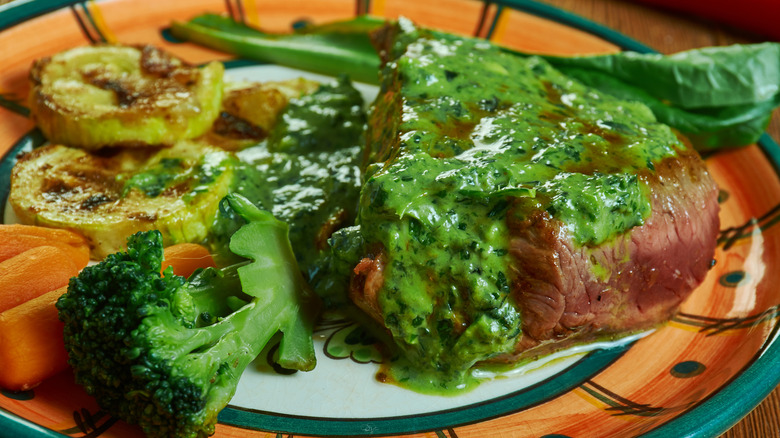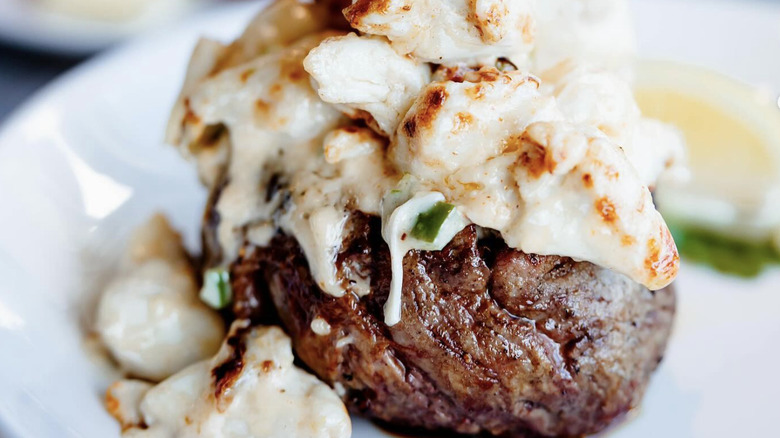13 Regional Steak Styles You Need To Try At Least Once
A steak is the entrée of choice for most any kind of meal, ranging from a casual backyard cookout to a celebration of a night out at a fancy restaurant. That combination of velvety beef protein and melting fat is certainly tasty, but a steak is also fairly easy to make. It's pretty just meat and heat — a cut like a ribeye, sirloin, filet, for example, and placed in a broiler or atop a gas or charcoal powered grill for a few minutes, and then turned until it reaches a desired level of doneness.
Making a steak is so straightforward that the process lends itself to variation and interpretation. There are so many ways to make, serve, or improve a steak, and those methods are inspired by regional or local culinary tastes, ingredient availability, and historical preference. North America is a big place, and numerous steak ideas from around the continent have become established over the decades, changing up the heat source, seasonings, and cuts used. Here are some of the best and most intriguing regional steaks from all over the United States, Canada, and Europe that one should seek out.
Chicago-style steak
As it's situated much farther north and typically endures far colder temperatures than do the Southern states, with their outdoor barbecue and grilling traditions, Chicago worked out its locally specific steak style in the kitchen. Traditionally prepared in a cast iron skillet at a high temperature, or placed under a broiler at a scorchingly hot level, a Chicago-style steak is ready to eat when it sports a nearly burnt, black-colored crispiness on the outside, but remains moist and flavorful on the inside, regardless of what level of doneness is desired.
Other aspects that make a Chicago-style steak more than just a piece of beef that's essentially overcooked on the outside but made just right in the middle: plenty of butter, the historical cooking fat for the dish, and the cut selected. A Chicago steak tends to be a lean strip steak of some kind, or a moderately marbled T-bone.
Idaho finger steaks
The potato is the food most people outside Idaho associate with the state. But inside Idaho, finger steaks are an iconic, signature dish. While serving as a meat cutter and chef in a kitchen operated by the U.S. Forest Service in central Idaho, Mylo Bybee couldn't afford to waste food in feeding his coworkers. He took the unused trimmings from various beef cuts used for other meals and got another one out of them. Bybee cut the beef into the size and shape of fingers, and breaded them in a flour mixture similar to what would be used on fried chicken or chicken fried steak. He deep-fried them in oil, and the finger steaks were a hit.
In the 1950s, Bybee had left the U.S. Forest Service and opened a restaurant in Boise the 1950s called Mylo's Torch Lounge. Its signature and most popular dish quickly became the finger steaks, which other Idaho restaurant chains, like the Red Steer, added to its menu.
Santa Maria tri-tip
Tri-tip is a regional food you can get anywhere these days, nearly three-quarters of a century after it was properly utilized and popularized in Santa Maria, California. In the 1950s, Bob Schutz, owner of the Santa Maria Market in the city a couple of hours away from Santa Barbara and Los Angeles, decided to treat the tri-tip like a proper, premium cut of beef. Up to that point, it wasn't highly prized by butchers, used to make into low-cost ground beef or stew meat.
The trip-tip isn't a particular type of steak, but rather a large portion of meat carved out of the top sirloin that tastes and cooks up like steak. Southern California cookouts called for a meat that could easily feed a family, and Schutz's Santa Maria tri-tip fit the bill. It's still much more commonly found on the West Coast than in other parts of the country.
Pittsburgh rare
In one of Pennsylvania's largest cities, the quintessential way to expertly order a steak in a restaurant is to ask for it "black and blue" or "Pittsburgh rare." Its colorful name describes the end result — it's cooked so that the outside bears a deep-black char, and the inside is barely cooked at all, so rare that the red or pink meat inside is closer to blue.
Pittsburgh has historically been an industrial city, home of a large steel-working industry. Reportedly the Pittsburgh rare steak was created by workers bringing cuts of meat into work and using the hot, metal-working surfaces that could register temperatures of 1,800 F or more to cook. Almost immediately, the steaks would cook and sear on the outside without the heat much penetrating into the inside, leaving the meat very rare. The result is a steak that's crispy and bitter but also juicy and velvety.
Carne Asada Tampiqueña
The regional favorite of Carne Asada Tampiqueña, from the north-central Mexican state of Tamaulipas isn't so much a popular cut of steak or a particular preparation, but instead a composed and arranged dish consisting of many different items, each with certain significance. Invented by chef and restaurateur brothers Fidel and José Inés Loredo and popularized at a Tampico restaurant in 1939, it's similar to the standard, modern fajitas presentation. Served whole rather than with sliced beef, the central item in Carne Asada Tampiqueña is skirt steak, pounded while it's still raw to make it thin, and then marinated for as much as an entire day, along with pieces of onion and poblano peppers in a blend of red wine, garlic, thyme, salt, and pepper.
After cooking in oil, the steak is presented on an oval plate alongside seasoned rice, beans, guacamole, and a cheese enchilada. According to the Loredos, the oval plate signifies the Mexican region of Huasteca, the meat represents the Rio Panuco river, the guacamole reminds the diner of the area's abundant cash crops, the beans of nature's bounty, and the cheese indicates the goodness of the local population.
Chicken fried steak
The United States' top beef producing states, by far, are Texas and Oklahoma. The neighboring south-central states raise about 6.6 million cattle a year collectively, and ranching is important to the region's culinary culture. Both states particularly treasure chicken fried steak. In 2011, the Texas legislature made October 26 "Chicken Fried Steak Day," celebrating the dish that's prepared with a dryer crust in the west, and a thicker, egg-based batter in the eastern part of the state. Oklahoma, where the thinner, crustier version is preferred, made chicken fried steak the centerpiece of its official state meal.
Exactly how chicken fried steak developed in Texas and Oklahoma is shrouded in historical mystery. German immigrants in the 19th century may have adapted recipes for wienerschnitzel (made out of veal instead of steak), while some food historians say it originated in the South at the beginning of the 1800s or in Kansas a bit later than that. At any rate, chicken fried steak involves a relatively simple preparation. Thin cuts of inexpensive and tough cube steak or round steak are tenderized by force and then coated in flour and fried up like one would pieces of chicken.
Kansas City and New York strip steaks
Across the United States, a cut of beef referred to by the umbrella term of strip steak is consistently popular. Fairly lean, moderately expensive, and served thick and narrow, the strip steak is cut from the sub-primal part of a steer, a section also known as the short loin, and the source for other desirable steaks such as the T-bone, porterhouse, and filet mignon. Two main varieties of strip steak are sold in supermarkets, butcher shops, and restaurants, the Kansas City strip and the New York strip. They are the same cut of beef, differentiated only by some superficial elements and likely the region where they are on offer.
Kansas City is located in the meat processing hotbed of Missouri, and that is where the Kansas City strip was first pinpointed, identified, and marketed. Then it was discovered by influential New York City chefs, who incorporated it onto their restaurants' menus and made it sound more glamorous (and expensive) by renaming it the New York strip. The cuts are interchangeable — what is sold as a New York strip steak in parts of the U.S. might be called a Kansas City strip steak in the Midwest and Southwest.
Subtle differences do exist. The Kansas City strip historically includes a small piece of bone on one end, or forming an L-shaped cradle; New York strips are invariably served boneless. A tail section of edible meat is left on a Kansas City that's trimmed off a New York strip, and both maintain a strip of fat. That's going to be thicker on the Kansas City than on the New York.
Boston strip steak
Certainly one of the latest-breaking location-specific beef cuts in the U.S., the Boston strip steak has only been a known, named entity since 2014. Carlo Crocetti, owner and operator of Crocetti's Butcher Shop in the Boston suburb of Bridgewater, it's quickly become a popular choice throughout New England in the decade since its introduction.
Often and previously overlooked by butchers as a viable steak option, Crocetti identified the meat found in the sirloin sub-primal region of the cow, cut from the bottom end of the sirloin flap. Sirloins tend to be naturally lacking in flavorful fat marbling or require some tenderizing or marinating to make them less chewy, but a quality Boston strip is laced with plenty of fat and tender after processing. Because it's a thin slice, it needs to be cooked in a certain way: fast, and over a direct flame at a high temperature.
Montreal steak
While the Montreal bagel is the superior breakfast bread, a Montreal-style steak is any individually prepared and cooked cut of beef that's been liberally coated in a specific, proprietary seasoning mixture developed in Quebec's cultural capital in the 1940s. The mixture, or rub, could be described as spicy, tangy, tart, sweet, hot, or all of the above, and it was born at a deli in Montreal long before anyone thought to use it on a steak.
In 1949, Morris Sherman, or "The Shadow," as he liked to be called, was working as a cook at Schwartz's, a restaurant that specializes in smoked meat dishes. Fancying himself a chef and a grill-master, he got bored and bold while cooking a steak one day. Eschewing the idea of a simple seasoning with salt, he used the standard Schwartz's meat-smoking spice on the steak. The flavors jumped out on the flash-cooked beef like they never had when used in the slower smoking process. Word of mouth helped spread the idea of a Montreal-seasoned steak to customers, while other restaurants in the delis tried to replicate the blend as best they could to meet demand. They also did what the still operational Schwartz's does well into the 21st century: They sell bottles of the spice mixture for home use. According to Schwartz personnel, the original Montreal steak spice blend combines coriander seed, mustard seed, black peppercorns, dried garlic, dried onion, paprika, salt, and some secret, spicy ingredients.
Texas-style smoked steak
Beef is big in Texas, and as far as steak is concerned, the conventional wisdom holds that less is more as far as ingredients and cooking technique is concerned. To prepare a steak — regardless of the cut selected — in a generally Texas fashion, one seasons it with a blend of salt, pepper, and garlic powder, and maybe a little bit of sugar. The meat should then rest and come to room temperature over the course of at least an hour before it reaches the heat.
As far as the cooking method is concerned, gas-powered grills and charcoal-fed barbecues have their fans. But it is just as traditional to get those seasoned steaks finished in a smoker, maintaining a temperature with oak or mesquite. After a very brief cooking period that allows smoke and heat to permeate the beef quickly, they're ready to eat after resting for a few minutes.
Azores-style steak
Along with other notable foods from Portugal, including a stew cooked by a volcano and Francesinha, the Portuguese sandwich beloved by Anthony Bourdain, is the steak made in its territorial islands. The Azores are situated in the Atlantic Ocean about 300 miles off the coast of Portugal, which oversees the self-governing area. Among this archipelago is Sao Miguel, home to a rustic, signature beef dish known outside the area as Azores-style steak, and within it bife a regional, Portuguese for "regional beef."
It is a locally favorable steak preparation made with specific cuts of and served with a topping hard to find outside of the Azores. Softer, more tender, less fatty steaks are preferred, typically filet mignon in nicer restaurants and in less formal situations, top sirloin, or cabeca de lombo. After a brief pan fry in olive, the steak is allowed to rest while a sauce is made from the juices left behind along with crushed garlic, pepper, salt, and butter. That concoction goes on top of the steak along with pimenta de terra, strips of locally-made spiced sweet peppers, as well as a fried egg.
Steak de Burgo
It has been called the signature dish of Iowa's capital city of Des Moines, and it is steak de burgo, a saucy, herby, meaty entree that can be found at restaurants all over town. It begins with tenderloin, a not particularly fatty and thus not particularly flavorful steak cut, which means it needs a bold sauce to come alive.
There's some debate as to which Des Moines restaurant first served steak de burgo back in the 1950s, possibly Vic's Tally Rand Club or Johnny and Kay's. Variations abound, but it's generally made by browning a steak in oil, and making a sauce in a white wine-deglazed cooking vessel with loads of herbs found in Italian cooking such as oregano, thyme, and basil, cream, butter, and garlic. The dish gets its name from Spanish history — after Generalissimo Franco's forces won the Spanish Civil War, it became unpopular and unwise to make reference to pre-war culture, even food. Aioli was renamed "burgo," after the city that served as Franco's base of operations. Once that sauce, or aioli, gets thick and then reduced, it's spooned over the steak. It's a distinctly Des Moines restaurant sensation to experience a steak de burgo emerging from a kitchen on its way to a table, giving off a rich, herbaceous smell recognizable to longtime Des Moines residents.
Filet Chesapeake
The Chesapeake Bay that juts off from coastal Maryland is a valuable economic and food resource to the region. The crab caught in and around the bay's waters makes the shellfish not only valuable but very common on menus and dinner tables. It is also the star ingredient in a local steak preparation, named after the area's generous waters. Chesapeake Filet Mignon is a high-end version of the iconic surf and turf combination, but served together as a dish instead of separately.
The highly regarded filet mignon, a small, mildly flavored and expensive steak, serves as a vessel for a rich and chunky crab sauce or soup. After the steak is buttered and browned, it's taken away for a minute to prepare the topping of the crab, cooked in a sauce of butter, shallots, mushrooms, cream, brandy, sherry, and tomato paste. That's all spooned atop the steak, adding powerfully creamy and crabby flavors to the luxurious beef.
